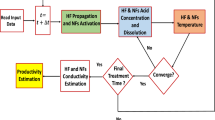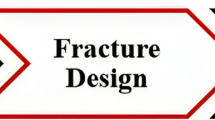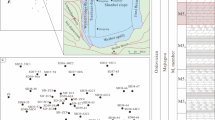Abstract
One of the fundamental ways to stimulate and increase the production rate of a well completed in a carbonate reservoir is acid fracturing. The amount of rock dissolved, fracture surface etching patterns, rock strength, and closure stress impacts the conductivity of the resulting acid fracture. A model of acid fracturing conductivity must accurately anticipate fracture conductivity versus closure stress. There are two parts for an acid fracture model: fracture conductivity at zero closure stress and the rate of conductivity change with closure stress. The fracture conductivity is substantially influenced by rock type. A serious challenge in recent studies has been to predict behaviour of different formations under various closure stresses. Furthermore, treatment parameters like acid injection rate and acid strength have different effects on fracture conductivity, depending on formation type. This study develops artificial neural network models to precisely predict fracture conductivity by incorporating experimental data from various formations, thereby resulting in a good match between model predictions and experimental data. The effects of rock type and treatment parameters on fracture conductivity are investigated and show that different formations have different responses under various closure stresses. There is an optimum point at which maximum fracture conductivity is achieved, but finding this point is difficult because it is distinct for different formations.
Similar content being viewed by others
Abbreviations
- DREC:
-
Dissolved rock equivalent conductivity
- \({\sigma }_{\mathrm{c}}\) :
-
Closure stress
- \({k}_{\mathrm{f}}{w}\) :
-
Fracture conductivity
- \(\overline{{k}_{\mathrm{f}}{w}}\) :
-
Mean of the measured fracture conductivities
- n :
-
Number of data
- RES:
-
Rock embedment strength
- NSD:
-
Nasr-El-Din
- N&K:
-
Nierode and Kruk
References
Kalfayan, L.J.: Fracture acidizing: history, present state, and future. In: Paper SPE-106371 Presented at the 2007 SPE Hydraulic Fracturing Technology Conference, College Station, Texas, USA, 29–31 January (2007)
Al-Mutairi, S.H.; Hill, A.D.; Nasr-El-Din, H.A.: Fracture conductivity using emulsified acids: effects of emulsifier concentration and acid volume fraction. In: Paper IPTC 12186 Presented at the International Petroleum Technology Conference Held in Kuala Lumpur, Malaysia, 3–5 December (2008)
Melendez, M.G.; Pournik, M.; Zhu, D.; Hill, A.D.: The Effects of Acid Contact Time and the Resulting Weakening of the Rock Surfaces on Acid-Fracture Conductivity. In: Paper SPE-107772 Presented at the SPE European Formation Damage Meeting, Scheveningen, Netherlands, 30–1 May–June (2007)
Malagon, C.; Pournik, M.; Hill, A.D.: The texture of acidized fracture surfaces-implications for acid fracture conductivity. SPE Prod Oper 23(3), 343–352 (2008). SPE-102167
Nierode, D.E.; Kruk, K.F.: An evaluation of acid fluid loss additives, retarded acids, and acidized fracture conductivity. In: Paper SPE-4549 Presented at the 48th Annual Fall Meeting of Society of Petroleum Engineering of AIME, Las Vegas, Nevada, USA (1973)
Van Domselaar, H.R.; Schols, R.S.; Visser, W.: An analysis of the acidizing process in acid fracturing. SPEJ 8, 239–250 (1973). SPE-3748.
Coulter, A.W.; Alderman, E.N.; Cloud, J.E.; Crowe, C.W.: Mathematical model simulates actual well conditions in fracture acidizing treatment design. In: Paper SPE-5004 Presented at the SPE_AIME 49th Annual Fall Meeting, Houston, Texas, USA, 6–9 October (1974)
Roberts, L.D.; Guin, J.A.: The effects of surface kinetics in fracture acidizing. SPEJ 8, 385–395 (1975). SPE-4349.
Anderson, M.S.; Fredrickson, S.E.: Dynamic etching tests aid fracture-acidizing treatment design. SPE Prod. Eng. 4(4), 443–449 (1989). SPE-16452.
Beg, M.S.; Kunak, A.O.; Gong, M.; Zhu, D.; Hill, A.D.: A systematic experimental study of acid fracture conductivity. SPEPF 13(4), 267–271 (1998). SPE-52402.
Ruffet, C.S.; Fery, J.J.; Onaisi, A.: Acid-fracturing treatment: a surface-topography analysis of acid-etched fractures to determine residual conductivity. In: Paper SPE-38175 Presented at the SPE European Formation Damage Conference, The Hague, The Netherlands, 2–3 June (1997)
Gong, M.; Lacote, S.; Hill, A.D.: New model of acid-fracture conductivity based on deformation of surface asperities. SPEJ 4(3), 206–214 (1999). SPE-57017.
Mou, J.; Zhu, D.; Hill, A.D.: Acid-etched channels in heterogeneous carbonates–a newly discovered mechanism for creating acid fracture conductivity. In: Paper SPE-119619 Presented at the 2009 SPE Hydraulic Fracturing Technology Conference, The Woodlands, Texas, USA, 19–21 January (2009)
Williams, B.B.; Gidley, J.L.; Schechter, R.S.: Acidizing Fundamentals. Society of Petroleum Engineers, Richardson (1979)
Gomaa, A.M.; Nasr-El-Din, H.A.: Acid fracturing: the effect of formation strength on fracture conductivity. In: Paper SPE-119623 Presented at the 2009 SPE Hydraulic Fracturing Technology Conference, The Woodlands, Texas, USA, 19–21 January (2009)
Pournik, M.: Laboratory-Scale Fracture Conductivity Created by Acid Etching. PhD dissertation, Texas A&M University, College Station, Texas, USA (2008)
Garrouch, A.; Smaoui, N. H.: An artificial neural network for estimating tight gas sand permeability. In: Paper SPE 39703 Presented at the 1998 SPE Asia Pacific Conference on Integrated Modelling for Asset Management, Kuala Lumpur, Malaysia (1998)
Leonid, S.; Lun, L.: IOR evaluation and applicability screening using artificial neural networks. In: Paper SPE 59308 Presented at the 2000 SPE/DOE Improved Oil Recovery Symposium, Tulsa, OK, USA (2000)
Demuth, H.; Beale, M.: Neural Network Toolbox for Use with MATLAB, User’s Guide, Fifth Printing, Version 3. Mathworks, Natick, MA (1998)
Jain, A.K.; Jianchang, M.; Mohiuddin, K.M.: Artificial neural networks: a tutorial. J. Comput. 29(3), 31–44 (1996)
Nasr-El-Din, H.A.; Al-Driweesh, S.M.; Metcalf, A.S.; Chesson, J.B.: Fracture acidizing: what role does formation softening play in production response? SPE Prod. Oper. 23(2), 184–191 (2008). SPE-103344
Author information
Authors and Affiliations
Corresponding author
Rights and permissions
About this article
Cite this article
Akbari, M.R., Ameri, M.J. & Pournik, M. Study of the Effect of Rock Type and Treatment Parameter on Acid Fracture Conductivity Using an Intelligent Model. Arab J Sci Eng 42, 1601–1608 (2017). https://doi.org/10.1007/s13369-016-2283-3
Received:
Accepted:
Published:
Issue Date:
DOI: https://doi.org/10.1007/s13369-016-2283-3




